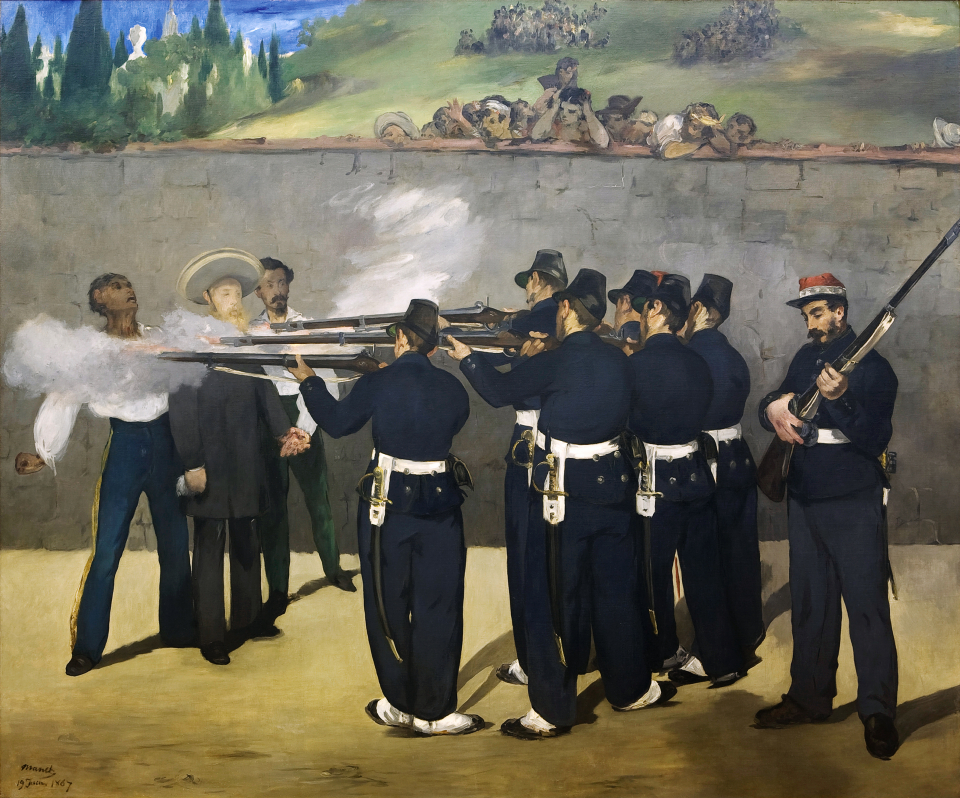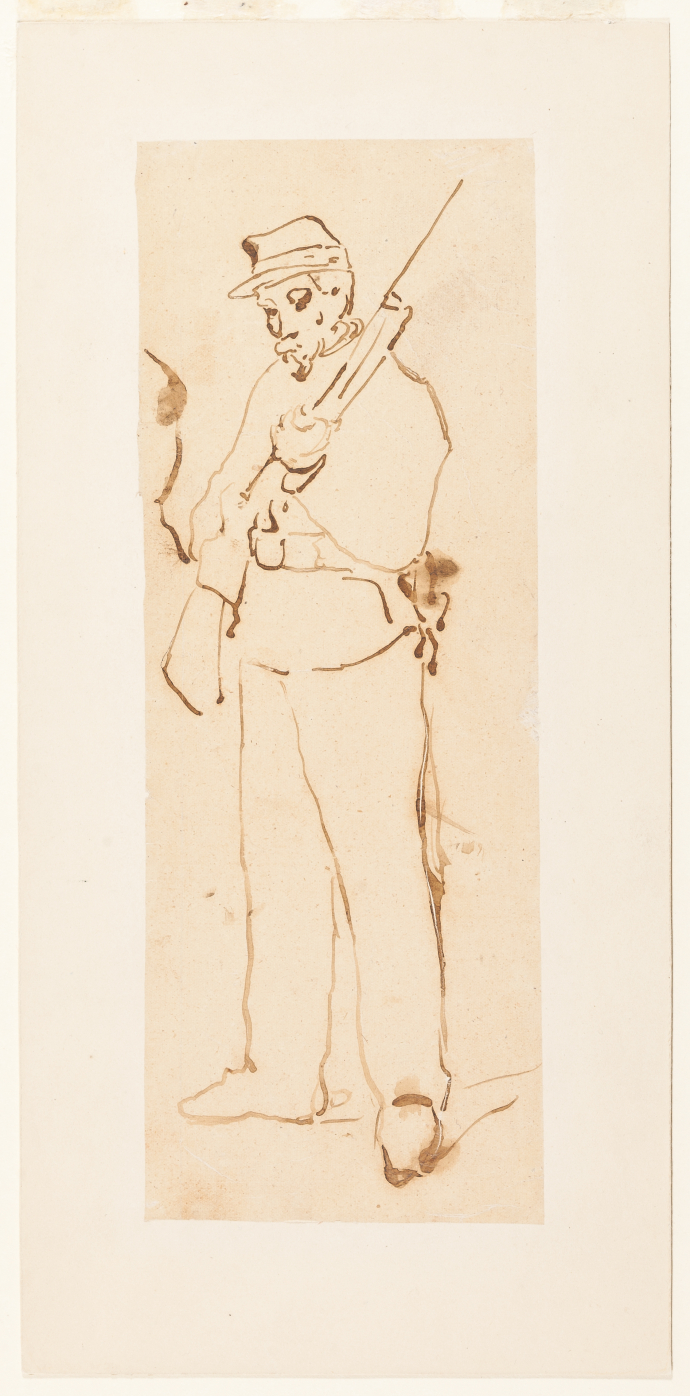L'exécution de l'empereur Maximilien
Hector-Bau > Ebene 1 > Kubus 1
Intro
Manet’s large-format painting is the Kunsthalle’s central masterpiece and, as an early purchase from 1910, represents the actual beginning of the painting collection.
With his depiction of the execution of the French-installed Emperor Maximilian I of Mexico, which Manet worked on from 1868 to 1869, the painter responded to a violent conflict between the French empire and the Mexican republicans.
The picture shows the firing squad, a compact group, also highlighted through the use of color, in the instant the soldiers shoot, but before the bullets reach the emperor. Manet explored the topic in a number of preliminary works, gathering information about the event in the form of contemporary photographs, which were forbidden due to political censorship in France. The frozen instant of photography forms the heart of the painting, preserving the scene’s entire human and historical drama for all time.
Background
With his history painting, »The Execution of Emperor Maximilian«, created in 1868/69, the French artist Édouard Manet focussed his attention on the actual moment of the shooting. The painting depicts the execution of Emperor Maximilian and his generals, Mejía and Miramón, by a Mexican Republican firing squad. The soldiers have already pulled the trigger, but the bullets have not yet reached the three main protagonists. The stage of the event is provided by an austere landscape with a wall in the background, over which a group of curious bystanders is looking. In spite of the dramatic nature of the monumental scene, this principal work in the Mannheim French collection is characterised by a distant and objective representation as well as a rapid, apparently unfinished painting style and a cool colour scheme.
Manet’s interest in the historic event was prompted by reports of the execution of Emperor Maximilian in Querétaro on 19 June, 1867. Three years after the coronation of the Habsburg Archduke Maximilian as Emperor of Mexico, his execution marked the final failure of the attempts of the Second Empire at conquest, leading at the same time to the collapse of French foreign policy in Central America. Shortly after this political disaster, Manet embarked on a study of the subject which would last for almost two years. He worked the results into two versions of the painting, an oil study and a lithograph. He created the final version, on view in Mannheim, in 1868/69.
In it, he makes reference to Goya’s The Third of May 1808, now in the collection of the Prado in Madrid. In the Mannheim painting, the viewer stands directly in front of the firing squad. The eye-witnesses of the event, who can be seen looking over the wall, also serve to mirror the position of the audience in front of the picture and draw attention to their fictitious presence at the scene. Moreover, Manet did not sign the composition with the date of completion, but rather with the historic date, thereby intimating his own fictitious presence as a witness.
Manet, however, counterbalances the drama of the moment by formal elements of the composition: He positions the delinquents on the left and the firing squad on the right like a tympanum, with the bystanders raised and the ornamental and rhythmic effects of the row of figures heightened by repetitions of colour and shape. Moreover, with the junior officer at the right-hand edge of the picture, the artist introduces a reflection figure. It is a soldier who appears to be preparing the coup de grâce, but who remains detached from the action.
The curious, blurred flatness of some parts of the picture corresponds altogether with the lack of certainty of the actors. Instead of exuding great excitement, their facial expressions seem empty, as if Manet had erased their physiognomy in his painting. Édouard Manet, the portraitist of modern city life, was also the “Father of the Impressionists” and a determined supporter of painterly autonomy, which began to develop with the tendency to the “unfinished” in painting.
At the same time, with the artistic simulation of immediacy and by dressing the soldiers in French uniforms, he transformed the historical event into a contemporary reportage and, with the “only monumental history picture in modern painting”, commented on the current political situation in his home country. By doing so, Manet radically questioned not only the traditional approach to French history painting but also the nineteenth-century tradition of academic painting as a whole.
About
To begin, a scandal: With one of his very first purchases the founding director Fritz Wichert pulled of a coup which attracted considerable attention in the national press and amongst experts—as well as provoking enormous opposition. With this acquisition Wichert joined ranks with a number of other directors from large German museums in the battle over modernism. Mannheim suddenly saw itself at the center of a German-wide discussion on French painting—a debate which was shaped by both issues of art history and politics.
The painting itself had already provoked a scandal during Manet’s lifetime, with the artist giving expression to the failure of France’s foreign policy in Central America by depicting Emperor Maximillian as the victim. In 1867, shortly following the political disaster, Manet began to address this theme. He explored it in three versions of the painting, an oil study, a drawing, and a lithograph. The version of the painting in Mannheim is the third and last. It was subject to an exhibition ban, and the lithograph was first published after Manet’s death. Incidentally, Manet also employed parts of the composition in a lithograph from 1871 which depicted the fighting on the barricades during the French Civil War.
The Purchase
In his collection concept, presented in 1910, Fritz Wichert placed the accent on classical French painting of the 19th century, which he considered exemplary. Thus the acquisition of Manet’s painting, undertaken shortly after he assumed office, was the appropriate realization of this concept. Looking back, the speed and the circumstances of this purchase are astounding, with the asking price of 90,000 Mark being raised by nine citizens of Mannheim. The transaction was skillfully accompanied by Wichert’s press work, which also aimed to portray the purchase as an event of great national importance. In a newspaper article from January 1910 he already looked proudly into the future: “This picture will prove to bring lasting fame to our gallery. Anyone visiting the southern German museums cannot pass over the city of Manet’s ‘Execution’ unheeding. It alone will ensure that Mannheim will occupy a prominent position amongst the gallery cities of note…; this will not be temporary, but for all time.”
The Painting as a Guest in Berlin
No sooner had it arrived in Mannheim than the picture was requested for the summer exhibition of the Secession in Berlin. Its chairman, Max Liebermann, wrote in his loan request: “However, the presentation of your picture should also serve as a model for the museum administration in the capital of the German Reich: Berlin will have the opportunity to admire the great insight of the Mannheim gallery, which has just purchased this work from Manet that displays all his qualities to the highest degree.” In the introduction to the Secession catalogue Liebermann presented the picture as an example of his conception of art, which he distinguished from that of Expressionist painting. Thus Manet’s picture became a focal point for artistic disputes which led to a split within the artists’ association, and ultimately to the founding of the New Secession.
“The Battle Over Art”
Above all, nationalist circles attacked the French-oriented acquisition policy of German museums. In Mannheim this opposition was personified by the lawyer and city councilor Theodor Alt, who presented his opinions in an over 500 page book published in 1911 with the title “Die Herabwertung der deutschen Kunst durch die Parteigänger des Impressionismus” (The Degradation of German Art by the Advocates of Impressionism).
However, the previous year, opposition had already been raised to the avant-garde acquisition policy of the director of the Kunsthalle in Bremen, Gustav Pauli, triggered by his purchase of Vincent van Gogh’s “Poppy Field”. The spokesman was the painter Carl Vinnen with his brochure “Ein Protest deutscher Künstler“ (A Protest from German Artists), which was signed by 140 artists and art critics. Its theme was the “foreign infiltration” of the museums by the French and the discrimination of German artists as an expression of a false museum policy. The most important elements of the protest related to nationalist, artistic, and financial issues. The refutation, “Im Kampf um die Kunst” (The Battle Over Art), appeared in July 1911 and featured responses to Vinnen’s polemic from 47 artists—including Max Beckmann, Lovis Corinth, Wassily Kandinsky, Max Liebermann, August Macke, Franz Marc, and Max Slevogt—as well as 28 gallery owners and art critics.
In Alfred Walther Heymel’s contribution it states: “We sincerely regret that the contribution from the director of the Kunsthalle, Fritz Wichert, is missing, and that for the sole reason that he was unable to deliver it due to overwork. As Wichert is indirectly one of the main people under attack ..., his opinions would have been especially valuable. However, he has no need to defend himself as many powerful words have been spoken in his favor, and his actions in the Kunsthalle Mannheim represent a loud, eloquent testimony in support of the accused.”
It quickly became clear that the accusation that French art was being privileged was indefensible on purely statistical grounds. However, Vinnen and Alt’s nationalist tones recurred in many of the art debates of the Weimar period, before culminating in the art propaganda of the National Socialists.
Kunsthalle Mannheim
Transkription
Six soldiers are firing, point-blank, at a pale man with a blonde beard wearing a sombrero. He is standing straight on the sandy square and appears very calm, but his left hand is gripping that of his companion. The dark-skinned soldier to his right is throwing his head back with a gaping mouth: he is hit! An angry crowd clings to the background wall. One officer turns away. Did he finish his shot? Is he checking his rifle so that the others will finish the shooting without him? Or is he cocking his gun to prepare for the coup de grace?
Parisian painter, etcher and lithographer Édouard Manet worked for more than a year on the motif of the execution of Emperor Maximilian. Over and over again he changed the structure of his painting and its technique. This 2½ by 3 m oil painting is his final version of an event which caused a huge political stir in Europe at the time: On June 19th, 1867 several soldiers executed 35-year-old Hapsburg Archduke Maximilian, brother of Austrian Emperor Franz Josef, on a hill north of the Mexican capital.
Napoleon III. had installed Maximilian as Emperor of Mexico to strengthen his own influence in the country. Soon, Maximilian lost the support of his allies. When, in 1866, the US intervened in the conflict, the French occupation troops withdrew. President Benito Juárez dethroned Maximilian, and a military court sentenced him to death.
Unlike the usual depictions of historical events at the time, Manet does not show any heroism. His firing squad is wearing fantasy outfits reminiscent of French uniforms. That was both a pictorial decision and a political statement. The writer Émile Zola, a friend of the painter, bluntly translated this statement as: „France is shooting Maximilian!“
We see how strongly Manet felt about recording this particular political moment when we examine the artist’s mark at the bottom left: under his signature we find not the usual finishing date of the painting, but rather the date of the execution: June 19th, 1867.


![L´éxecution de Maximilien Beschriftung verso: mi.: "334/zw" [unterstrichen] // "80.-" // "S.": Signatur: im Stein u.li.: "Manet": Beschriftung recto: auf Trägerblatt unter dem Druck mi. gedruckt: "Imp. Lemercier et Cie Paris .", u.li.: "La Mort de Maximilien", radierte Bleistiftbeschriftung u.mi.: "60"](/sites/default/files/styles/700_breit/public/digitalisate/G14_MOS_2018.jpg?itok=mwsImnq8)
